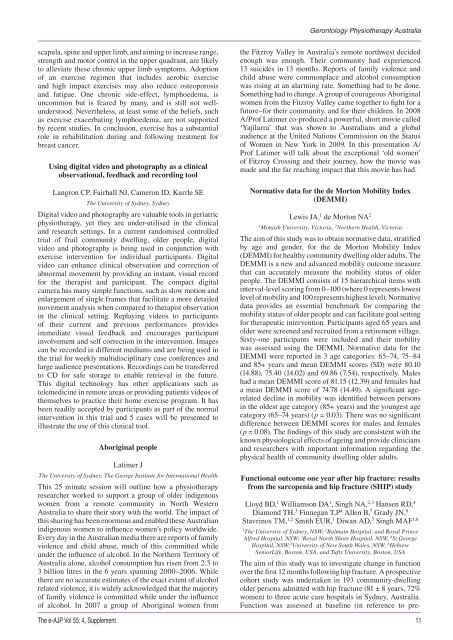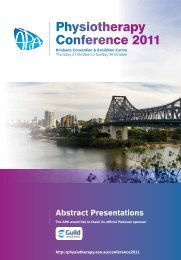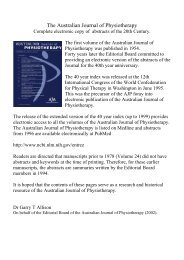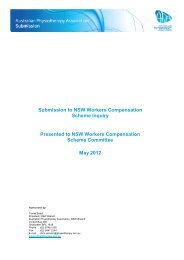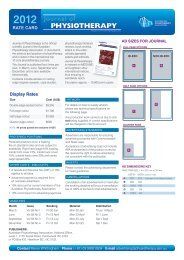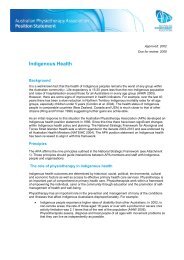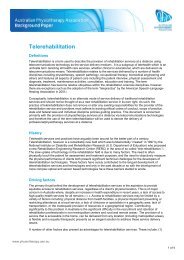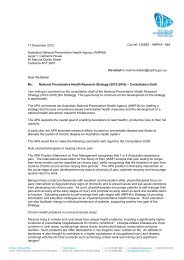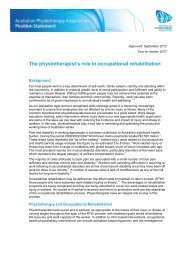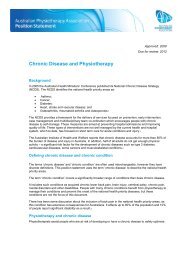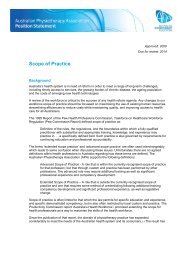2009 APA Conference Week Abstracts - Australian Physiotherapy ...
2009 APA Conference Week Abstracts - Australian Physiotherapy ...
2009 APA Conference Week Abstracts - Australian Physiotherapy ...
Create successful ePaper yourself
Turn your PDF publications into a flip-book with our unique Google optimized e-Paper software.
Gerontology <strong>Physiotherapy</strong> Australia<br />
scapula, spine and upper limb, and aiming to increase range,<br />
strength and motor control in the upper quadrant, are likely<br />
to alleviate these chronic upper limb symptoms. Adoption<br />
of an exercise regimen that includes aerobic exercise<br />
and high impact exercises may also reduce osteoporosis<br />
and fatigue. One chronic side-effect, lymphoedema, is<br />
uncommon but is feared by many, and is still not wellunderstood.<br />
Nevertheless, at least some of the beliefs, such<br />
as exercise exacerbating lymphoedema, are not supported<br />
by recent studies. In conclusion, exercise has a substantial<br />
role in rehabilitation during and following treatment for<br />
breast cancer.<br />
Using digital video and photography as a clinical<br />
observational, feedback and recording tool<br />
Langron CP, Fairhall NJ, Cameron ID, Kurrle SE<br />
The University of Sydney, Sydney<br />
Digital video and photography are valuable tools in geriatric<br />
physiotherapy, yet they are under-utilised in the clinical<br />
and research settings. In a current randomised controlled<br />
trial of frail community dwelling, older people, digital<br />
video and photography is being used in conjunction with<br />
exercise intervention for individual participants. Digital<br />
video can enhance clinical observation and correction of<br />
abnormal movement by providing an instant, visual record<br />
for the therapist and participant. The compact digital<br />
camera has many simple functions, such as slow motion and<br />
enlargement of single frames that facilitate a more detailed<br />
movement analysis when compared to therapist observation<br />
in the clinical setting. Replaying videos to participants<br />
of their current and previous performances provides<br />
immediate visual feedback and encourages participant<br />
involvement and self correction in the intervention. Images<br />
can be recorded in different mediums and are being used in<br />
the trial for weekly multidisciplinary case conferences and<br />
large audience presentations. Recordings can be transferred<br />
to CD for safe storage to enable retrieval in the future.<br />
This digital technology has other applications such as<br />
telemedicine in remote areas or providing patients videos of<br />
themselves to practice their home exercise program. It has<br />
been readily accepted by participants as part of the normal<br />
intervention in this trial and 5 cases will be presented to<br />
illustrate the use of this clinical tool.<br />
Aboriginal people<br />
Latimer J<br />
The University of Sydney, The George Institute for International Health<br />
This 25 minute session will outline how a physiotherapy<br />
researcher worked to support a group of older indigenous<br />
women from a remote community in North Western<br />
Australia to share their story with the world. The impact of<br />
this sharing has been enormous and enabled these <strong>Australian</strong><br />
indigenous women to influence women’s policy worldwide.<br />
Every day in the <strong>Australian</strong> media there are reports of family<br />
violence and child abuse, much of this committed while<br />
under the influence of alcohol. In the Northern Territory of<br />
Australia alone, alcohol consumption has risen from 2.3 to<br />
3 billion litres in the 6 years spanning 2000–2006. While<br />
there are no accurate estimates of the exact extent of alcohol<br />
related violence, it is widely acknowledged that the majority<br />
of family violence is committed while under the influence<br />
of alcohol. In 2007 a group of Aboriginal women from<br />
the Fitzroy Valley in Australia’s remote northwest decided<br />
enough was enough. Their community had experienced<br />
13 suicides in 13 months. Reports of family violence and<br />
child abuse were commonplace and alcohol consumption<br />
was rising at an alarming rate. Something had to be done.<br />
Something had to change. A group of courageous Aboriginal<br />
women from the Fitzroy Valley came together to fight for a<br />
future–for their community, and for their children. In 2008<br />
A/Prof Latimer co-produced a powerful, short movie called<br />
‘Yajilarra’ that was shown to <strong>Australian</strong>s and a global<br />
audience at the United Nations Commission on the Status<br />
of Women in New York in <strong>2009</strong>. In this presentation A/<br />
Prof Latimer will talk about the exceptional ‘old women’<br />
of Fitzroy Crossing and their journey, how the movie was<br />
made and the far reaching impact that this movie has had.<br />
Normative data for the de Morton Mobility Index<br />
(DEMMI)<br />
Lewis JA, 1 de Morton NA 2<br />
1<br />
Monash University, Victoria, 2 Northern Health, Victoria<br />
The aim of this study was to obtain normative data, stratified<br />
by age and gender, for the de Morton Mobility Index<br />
(DEMMI) for healthy community dwelling older adults. The<br />
DEMMI is a new and advanced mobility outcome measure<br />
that can accurately measure the mobility status of older<br />
people. The DEMMI consists of 15 hierarchical items with<br />
interval-level scoring from 0–100 (where 0 represents lowest<br />
level of mobility and 100 represents highest level). Normative<br />
data provides an essential benchmark for comparing the<br />
mobility status of older people and can facilitate goal setting<br />
for therapeutic intervention. Participants aged 65 years and<br />
older were screened and recruited from a retirement village.<br />
Sixty-one participants were included and their mobility<br />
was assessed using the DEMMI. Normative data for the<br />
DEMMI were reported in 3 age categories: 65–74, 75–84<br />
and 85+ years and mean DEMMI scores (SD) were 80.10<br />
(14.88), 75.40 (14.02) and 69.86 (7.54), respectively. Males<br />
had a mean DEMMI score of 81.15 (12.39) and females had<br />
a mean DEMMI score of 74.78 (14.49). A significant agerelated<br />
decline in mobility was identified between persons<br />
in the oldest age category (85+ years) and the youngest age<br />
category (65–74 years) (p = 0.03). There was no significant<br />
difference between DEMMI scores for males and females<br />
(p = 0.08). The findings of this study are consistent with the<br />
known physiological effects of ageing and provide clinicians<br />
and researchers with important information regarding the<br />
physical health of community dwelling older adults.<br />
Functional outcome one year after hip fracture: results<br />
from the sarcopenia and hip fracture (SHIP) study<br />
Lloyd BD, 1 Williamson DA 1 , Singh NA, 2,3 Hansen RD, 4<br />
Diamond TH, 3 Finnegan T,P 4 Allen B, 7 Grady JN, 8<br />
Stavrinos TM, 1,2 Smith EUR, 1 Diwan AD, 5 Singh MAF 1,6<br />
1<br />
The University of Sydney, NSW; 2 Balmain Hospital, and Royal Prince<br />
Alfred Hospital, NSW; 3 Royal North Shore Hospital, NSW, 4 St George<br />
Hospital, NSW; 5 University of New South Wales, NSW, 6 Hebrew<br />
SeniorLife, Boston, USA, and Tufts University, Boston, USA<br />
The aim of this study was to investigate change in function<br />
over the first 12 months following hip fracture. A prospective<br />
cohort study was undertaken in 193 community-dwelling<br />
older persons admitted with hip fracture (81 ± 8 years, 72%<br />
women) to three acute care hospitals in Sydney, Australia.<br />
Function was assessed at baseline (in reference to pre-<br />
The e-AJP Vol 55: 4, Supplement 11


